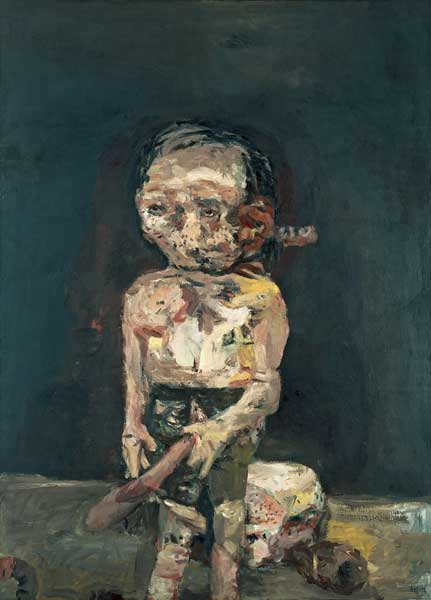Great Works: The Big Night Down the Drain 1962-3 (250 x 180cm), Georg Baselitz
Museum Ludwig, Cologne

This painting seems to be waging war upon refinement of any kind. It is not asserting its own beauty – in fact, quite the opposite. It is not harmonious. In fact, it is lumpen, squat, gross and lumpish. It is not tailored to appeal to any market. It would not sit e asily above the mantelpiece in the home. It is the very epitome of savagery, tastelessness, ugliness, offensiveness, crudeness and ferocious defiance. It seems to exist in order to be nothing but that, a fist shaken in the face of the respectable and self-possessed onlooker.
The masturbating dwarf stares blankly, not ahead, but to the side. He is ridiculously small in stature, slightly knock-kneed, dressed in what might be lederhosen. The eyes are small and mean, ridiculously wide-spaced, deep-sunken within their sockets, hollowed out, the pupils defined against the eyes' grey-black outlining. The look is leaden, mechanised, wallowing in its own emptiness, beyond the call of morality. The nose is a flattened, mashed agglomeration of smeary colours. Everywhere there are nasty little lumps, swellings, excrescences, evidence of abnormality. We feel that the figure believes himself to be as massive and as indomitable as any Titan – such is his steady, purposeful look of leaden menace. The visual truth is the exact opposite. He is laughably small and slight, ungainly, easily swept aside, utterly preposterous and anti-heroic.
He holds the disgustingly extended penis out in front of him, as if he is engaged in the act of swinging it from side to side, wielding it like a cosh. This is his only weapon. The hands look too small and malformed, the fingers awkwardly crossed over each over, the blooded left ear so grotesquely large that it must have been pummeled, repeatedly. The face is a messy blur of ill-defined features, created from small, splattery, smeary wedgings of paint.
The texture is messy and hectic looking, quite deliberately so. Did he paint parts of it with his thumb and fingers? Possibly. The individual dibs and dabs of paint go in so many different directions. There is no feeling of easy flow, no attempt to disguise the fact that this has been a laborious build up of paint, an extended act of raw application of crude colour. There is no context for this figure. He stands, weakly defiant, preparing himself for the next approach, in the middle of the canvas, against the darkest of dark grounds, a figure punily defined against nothing. There is no hint of a landscape of any kind. He is from nowhere. He stands in a nowhere place – no man's land, in fact. He is everyman – or perhaps he is the no-man of that world. The only figure against which he is defined is a second human form on the floor, on its side. Dead? Almost certainly. A slumped corpse, partially concealed, legs drawn back, by the standing figure. Once again, the figure is very crude and ill defined. One important detail links the standing figure with the recumbent corpse – a fierce redness. The same red that is used to define the hugely swollen ear of the standing figure, and that reappears, in spattery smears, on his chest, arms, penis and legs, is also smeared on the corpse, quite close to his neck.
This was one of a group of paintings made by Georg Baselitz for his first exhibition in West Berlin at the Galerie Werner & Katz in 1963. The entire show was confiscated by the police on the grounds of obscenity. Many of the works in that show consisted of close scrutinisings of human flesh, and especially of the foot and the lower leg. Every one of them has that same raw, pitiless quality. Baselitz is staring at something that might be repulsive to him. They were being made at a time when many artists were being seduced by the formal qualities of abstraction, the coolness of minimalism. Baselitz, by comparison, who as a boy had huddled in the village schoolhouse as the Allied planes bombed nearby Dresden, could not go down that road. He was seeking out his own response to a more urgent question: how and what could a German painter paint in the aftermath of the humiliations of war, in the aftermath of the atrocities of Hitler? Abstraction was to step back too far. Abstraction would be a dereliction of duty. So he chose to anatomise, ruthlessly, human flesh, to search into it, to mock it for its ridiculous fanfarings of its own heroic qualities. And in the painting on this page, he made his own portrait of that ludicrous immoralist Adolf Hitler, the Austrian dwarf-man with the receding hairline, the sometime meagrely talented artist of schmalzily traditional scenes, wielding his bloody, penile cosh in the ever darkening wasteland of his own tragic devising.
ABOUT THE ARTIST
Georg Baselitz was born in Deutschbaselitz, Saxony, in 1938. He studied at the Hochschule fur Bildende Künste in East Berlin in 1956, but was soon ejected from there for what was then described as "socio-political immaturity". He is a painter of unmitigated savagery, a painter at whose works you are often inclined to wince at. When he does not paint, he fabricates crude, blockish, wooden sculptures of human forms with the aid of a chainsaw. He works very fast, and as he has aged he has worked faster still. He is a witness to terrible things. For many years he has painted the human figure upside down, as if the essential truth is the parallel to be drawn between man and shanks of dead meat on the butcher's hook.
Subscribe to Independent Premium to bookmark this article
Want to bookmark your favourite articles and stories to read or reference later? Start your Independent Premium subscription today.

Join our commenting forum
Join thought-provoking conversations, follow other Independent readers and see their replies